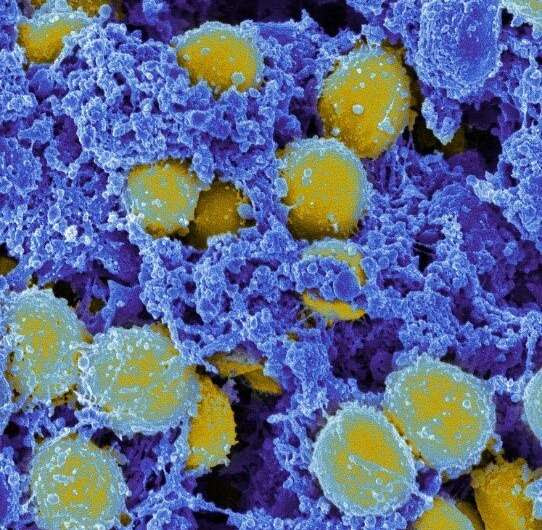by Bob Yirka , Medical Xpress

Scanning electromicrograph of Staphylococcus aureus bacteria. Credit: NIAID
A team of researchers at the Tohoku University Graduate School of Medicine, working with a colleague from Japan’s National Cancer Center, has found that the presence of Staphylococcus aureus on the skin of test mice with a lupus-like disease was found to worsen the disease’s symptoms. In their paper published in the journal Science Immunology, the group describes the impact of the bacteria on mice with Sjögren syndrome, an autoimmune disease that is present in lupus mouse models and many human patients.
Lupus and its associated syndromes are long-term conditions that are often debilitating. Patients typically suffer from systemic inflammation, joint pain, fatigue, hair loss, skin sensitivity and sometimes organ failure. There is no cure, but many therapies have been developed to reduce the symptoms.
The disease is believed to develop when the body mistakenly attacks some of its own cells. Prior research has suggested that bacterial infections, particularly those of the gut, may play a role in the onset of the disease. In this new effort, the researchers found evidence that bacteria on the skin may also play a role in its development.
The work began with collecting skin swabs from Sjögren syndrome mouse models. In studying the samples, the researchers found elevated levels of Staphylococcus aureus—a common skin bacteria. Taking a closer look, they found that the heighted levels of S. aureus resulted in increased production of a type of white blood cell called neutrophils, which in turn led to overproduction of neutrophil extracellular traps—such traps are created by the body to trap infected cells. That led to increased levels of inflammation due to an increase in production of cytokines in the skin.
The researchers found that removing S. aureus from the skin reduced symptoms. They also found that increasing the number of S. aureus on the skin led to stronger symptoms, including renal failure. They acknowledge that they do not yet know if the same might occur with human patients, but they plan to find out.

Leave a Reply